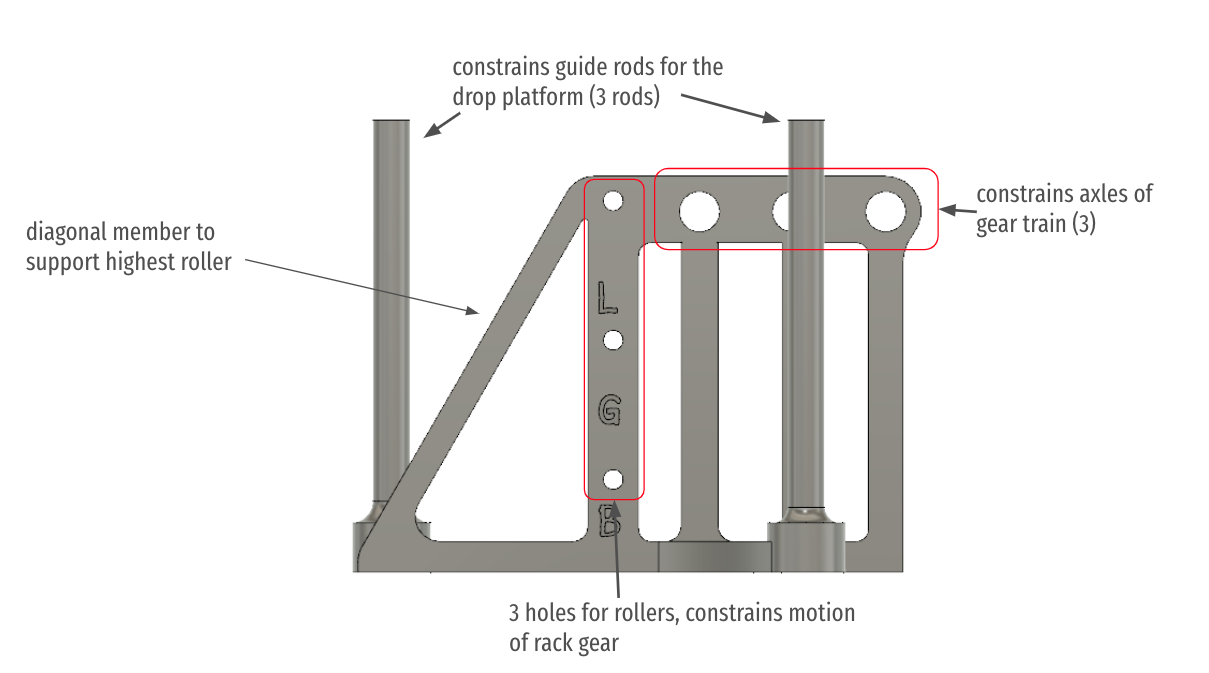Weight-Lifter
A lightweight mechanical elevator that utilizes gear ratios & mechanical advantage to lift a small mass a large distance.
Prompt
Create a machine that drops a large mass (10 kg) by 10 centimeter to lift a smaller mass (1 kg) by 1 meter.
The machine should be optimized for:
MASS - make the machine as lightweight as possible
EFFICIENCY - the machine should get as close to perfect energy efficiency a possible (minimal losses to gear friction)
Designing
Transmission
In order to convert 10 centimeters of downward linear motion into 1 meter of upward linear motion, we knew we needed a 1:10 gear ratio. In order to account for transmission losses due to friction between gear teeth and linear actuation, we estimated and aimed for a 1:10.7 transmission ratio.
We broke up the ratio into a compound gear train:
1:2 —> 1:2 —> 1:2.675
Then — considering the gear sizes, the coefficients of friction based on the material pairings, and the pressure angle of the gears — we calculated an expected energy transmission of 85.75%.
Calculations to achieve 1:10.7 ratio of linear motion
85.75% energy transmission meant that we’d lose 14.25% of our energy to friction.
To compensate for this, we’d need simply need to add 14.25% more mass to the drop mass.
Housing Structure
We designed a simple structure to constrain and support the following:
axles of gear train (3)
Linear motion of drop platform (rods)
deflective nature of rack and pinion
Optimizing for Mass
To get the members of our structure as thin as possible while still maintaining a reasonable factor of safety, we performed failure analysis on each member to calculate the most optimal dimensions.
Most members were at risk of buckling, so the following equation was used to maximize for member width while height and depth were held constant for other design reasons (i.e. printability, aesthetics, drop-distance limitations, etc.)
We then used Finite Element Analysis Simulations to highlight any stress concentrations within our structure. We used this feedback to redesign on a rolling basis — adding fillets, changing geometries, adding gussets, etc.
Simulated material was PLA at 50% infill density. Required us to manually customize physical properties of material.
Material & Component Selection
The primary metric of success for the project was energy transmission. Thus, with our limited budget, we decided to allocate $250 of our $300 budget towards quality gears + rack. As a result, our shaft collars, ball bearings, and steel rods had to be quite a bit cheaper, some of which came out of pocket.
For the housing, we decided to 3D print not only because of budget constraints (3D printing was free for us), but also because the forces on our project were low enough that it would do just as well as laser-cut aluminum. Also, from a time perspective, 3D printing would be significantly quicker than the nightmare of trying to machine and assemble the body while keeping everything aligned.
Results and Lessons
Results
Our project achieved the highest energy transmission in the class (89.98%), 4% better than previously calculated
This improvement was likely due to our generous use of grease, as well as quality brass gears
total machine weight came out to 0.5 kilograms (not including lift / drop masses)
Lessons
Working with a team — Most of my larger engineering projects up to this point had been solo projects, and this project took the better part of 6 weeks. It was interesting to work with two other people, who of which had different strengths and weaknesses than I did, which I found to be very fruitful in retrospect. In the latter half of the project, we learned how to distribute the work in order to play to our strengths, while still accommodating for our busy schedules with other commitments. I’m proud to say that our project went pretty flawlessly, and that’s including some mistakes and moments where we had to improvise. I’m even prouder to say that I created a lasting friendship with those guys.
The importance of alignment when working with gears — Although gears are a powerful tool, I hadn’t realized how much alignment mattered when dealing with gears. Gears that were too close simply wouldn’t move, gears that were too far apart would lose efficiency. Also, the amount of detail that goes into designing a functional gear was far more complex than I had anticipated.













